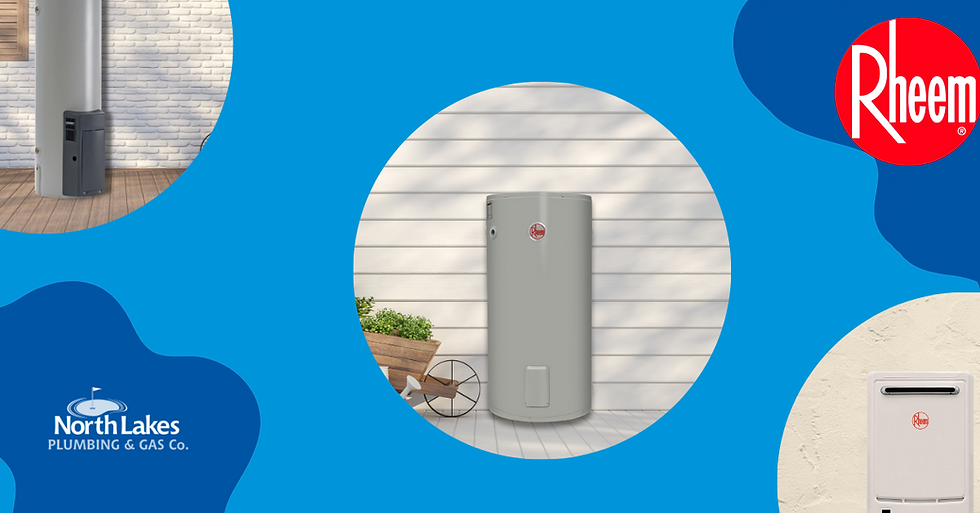Most Common Spots Leaks Happen In The Home
- North Lakes Plumbing & Gas Co

- Aug 25, 2022
- 4 min read
A tap drip doesn’t seem like the end of the world, but if you’ve ever had to put out a bucket to stop one, you know it adds up quickly. That’s a lot of water waste, and if that water is going somewhere you can’t see, that could spell disaster down the line.
We’ve created a list of the most common spots leaks occur in the home. Make sure to check everything on our list regularly if you want to prevent leaks from damaging your house.

1. Taps
Is your tap drip, drip dripping away? If yes, it may be more than just an annoyance. A leaky tap can be a money guzzler that can waste 9,000 litres of water a year! Luckily it tends to be an easy fix; just make sure your washers and O-rings aren’t worn out. If you’ve checked this and the dripping continues, let a plumber repair it for a guaranteed stop to the dripping.
2. Under Sink
The underside of your sink is probably covered in cabinetry, which makes spotting a leak here much harder. Make it a habit to touch the back wall and the pipes to ensure they’re dry every time you use those draws. If you store TP under your sink, or some paper towels and you notice they’re looking a bit warped or sunken-in, that’s another sign they’re absorbing moisture from a leak. Most commonly the rubbers on the waste pipework perish leaving a nasty surprise in your kitchen cabinetry when left unnoticed.
3. Toilet
Yuck, who wants a leaky toilet? Maybe Shreck. But if you’re not too keen on swamp foot, you probably want to keep your toilet water in the toilet. Leaks here tend to slowly seep out from the toilet cistern into the back of the bowel, if this goes undiscovered the toilet will continue to fill 24/7 tacking on a few extra litres to your water bill. Alternatively, they may leak from the base when flushed, especially if the sealant has been broken. Always call a plumber to handle your sewerage issues.
4. Water Heater
Water heater leaks can be tricky because there’s a chance it’s internal and being soaked into the insulation. The best way to spot a water heater leak is to listen closely for any irregular hissing or the sound of moving water. You can also determine if your heater has a leak if you’re struggling to get hot water in the house. Water heater leaks can also happen externally from the top or bottom of the system. Be sure to check all valves on the system to ensure they are dry at the point of discharge and not slow running. Often the drain line is hidden in the grass so look carefully. Be careful when inspecting any hot water system as scolding water can harm you on contact. It’s best to let a professional handle this job.

5. Washing Machine
Apart from your shower, your washing machine uses the most water in your house. A small leak in the pipework pipes can become a big problem. What makes things worse is most washing machines have their backs to the wall, or are surrounded by cabinetry. This means a small leak can go undetected until it pools up. Check the back of your machine regularly and feel the hoses and tapware to ensure they are dry.
6. Shower
Your shower probably spends more time wet than dry, and because of that, leak detection can be tricky. If you notice any stray streams of water running out of the skirting boards, on adjacent walls or water stains on your tiles, it could be a sign of a leak. If left unattended, shower leaks can promote mould growth or turn into calcium streaks.
7. Walls & Ceilings
A stain on your wall or ceiling may make your stomach drop. It’s a pretty clear sign something has gone wrong with the plumbing or roofing inside your home. The good news is that a stain will most likely be caused because of a smaller leak. Still, you’ll want to repair that asap. Major pipe leaks will take the form of dripping, paint bubbles or even holes in the drywall. A perished skylight or vent seal is a common cause of many roof leaks. If in a double-storey home check to see if a bathroom is directly above the leak spot. In many cases a fault in the bathroom drainage causes leaks.
8. Outdoors
Outdoor leaks are ignored more often than indoor leaks, but that choice may cost you lots of money. If your outdoor taps are surrounded by greener grass or mud, you may have a leak. Also, check the wall it's attached to for any signs of damage, staining or corrosion.
Burst underground pipes are another issue with outside plumbing. You can detect this by muddy spots or green spots on the lawn. Your lawn in this area may also grow taller than the rest. If you have a main line leak the rest of your plumbing will likely lose pressure. You can check this on your water meter. If you ever suspect a main leak, make sure to shut your water off immediately.
If you have a leak, North Lakes Plumbing & Gas Co. can fix it. Our plumbers are all highly experienced and will get the job done fast, within the quote, and with respect for you and your household. We can offer water efficiency and gas compliance certifications when required, and if you’re really stuck in a pickle, we offer emergency plumbing and after-hours services. We’re a one-stop shop for all of your plumbing needs! Contact us today to learn more or book your service.





Comments